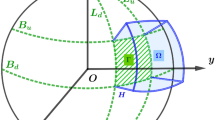Abstract
The Boundary Element Method (BEM), a numerical technique for solving boundary integral equations, is introduced to determine the earth's gravity field. After a short survey on its main principles, we apply this method to the fixed gravimetric boundary value problem (BVP), i.e. the determination of the earth's gravitational potential from measurements of the intensity of the gravity field in points on the earth's surface. We show how to linearize this nonlinear BVP using an implicit function theorem and how to transform the linearized BVP into a boundary integral equation using the single layer representation. A Galerkin method is used to transform the boundary integral equation using the single layer representation. A Galerkin method is used to transform the boundary integral equation into a linear system of equations. We discuss the major problems of this approach for setting up and solving the linear system. The BVP is numerically solved for a bounded part of the earth's surface using a high resolution reference gravity model, measured gravity values of high density, and a 50 ⋅ 50 m2 digital terrain model to describe the earth's surface. We obtain a gravity field resolution of 1 ⋅ 1 km2 with an accuracy of the order 10−3 to 10−4 in about 1 CPU-hour on a Siemens/Fujitsu SIMD vector pipeline machine using highly sophisticated numerical integration techniques and fast equation solvers. We conclude that BEM is a powerful numerical tool for solving boundary value problems and may be an alternative to classical geodetic techniques.
Similar content being viewed by others
References
Bjerhammar, A. and Svensson, L.: 1983, ‘On the Geodetic Boundary Value Problem for a Fixed Boundary Surface - A Satellite Approach’,Bullétin Géodésique 57, 382–393.
Costabel, M.: 1987, ‘Principles of Boundary Element Methods’,Computer Physics Reports 6, pp. 243–274.
Freeden, W. and Kersten, H.: 1981, ‘A Constructive Approximation Theorem for the Oblique Derivative Problem in Potential Theory’,Mathematical Methods in the Applied Sciences 3, 104–114.
Giraud, G.: 1934, ‘Equations Integrales Principales’,Annales Scientifiques de l'Ecole Normale Supérieure, Troisième Serie 51, 251–372.
Hayami, K. and Brebbia, C. A.: 1989, ‘Quadrature Methods for Singular and Nearly Singular Integrals in 3-D Boundary Element Method’, in C. A. Brebbias (ed.),Boundary Elements X, Proc. 10th Int. Conf., Southampton, U.K., Vol. 1, pp. 237–264.
Heck, B.: 1989, ‘On the Non-Linear Geodetic Boundary Value Problem for a Fixed Boundary Surface’,Bullétin Géodésique 63, 57–67.
Klees, R.: 1991, ‘Numerical Solution of the Fixed Gravimetric Boundary Value Problem Using Boundary Element Methods’,Paper presented on the occasion of XX IUGG General Assembly, Vienna, 11–23 August 1991.
Klees, R.: 1992, ‘Solution of the Fixed Geodetic Boundary Value Problem Using Boundary Element Methods’, Doctoral thesis, University of Karlsruhe (TH), F.R. Germany, DGK, Series C, No. 386, Munich 1992 (in German).
Klees, R. and Engels, J.: 1992, ‘Galerkin Versus Collocation -Comparison of Two Discretization Methods for Boundary Integral Equations.Manuscripta Geodaetica 17, 245–256.
Mikhlin, S. G.: 1965,Multidimensional Singular Integrals and Integral Equations. Pergamon Press, Oxford.
Protter, M. H. and Weinberger, H. F.: 1967,Maximum Principles in Differential Equations, Prentice Inc., Englewood Cliffs, New Jersey.
Taylor, M. E.: 1981,Pseudodifferential Operators, University Press, Princeton.
Telles, J. C. F.: 1987, ‘A Self-Adaptive Co-ordinate Transformation for Efficient Numerical Evaluation of General Boundary Element Integrals’,International Journal for Numerical Methods in Engineering 24, 959–973.
Wendland, W.L.: 1983, ‘Boundary Element Methods and their Asymptotic Convergence’, in P. Filippi (ed.),Theoretical Acoustics and Numerical Techniques, CISM Courses 277, Springer-Verlag, Wien pp. 135–216.
Wendland, W.L.: 1985, ‘On Some Mathematical Aspects of Boundary Element Methods for Elliptic Problems’, in J. Whiteman (ed.),Mathematics of Finite Elements and Applications V, Academic Press, London, pp. 193–227.
Zeidler, E.: 1986, ‘Nonlinear Functional Analysis and its Applications’,Vol. I:Fixed-point theorems. Springer-Verlag, New York.
Zhdanov, M. S.: 1988,Integral Transforms in Geophysics, Springer-Verlag, Berlin.
Author information
Authors and Affiliations
Rights and permissions
About this article
Cite this article
Klees, R. Gravity field determination using boundary element methods. Surv Geophys 14, 419–432 (1993). https://doi.org/10.1007/BF00690569
Received:
Issue Date:
DOI: https://doi.org/10.1007/BF00690569




